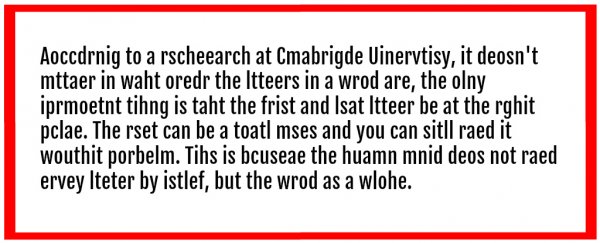You've probably seen the classic piece of "internet trivia" in the image above before - it's been circulating since at least 2003.
On first glance, it seems legit. Because you can actually read it, right? But, while the meme contains a grain of truth, the reality is always more complicated.
The meme asserts, citing an unnamed Cambridge scientist, that if the first and last letters of a word are in the correct places, you can still read a piece of text.
We've unjumbled the message verbatim.
"According to a researche [sic] at Cambridge University, it doesn't matter in what order the letters in a word are, the only importent [sic] thing is that the first and last letter be at the right place. The rest can be a total mess and you can still read it without problem. This is because the human mind does not read every letter by itself but the word as a whole."
In fact, there never was a Cambridge researcher (the earliest form of the meme actually circulated without that particular addition), but there is some science behind why we can read that particular jumbled text.
The phenomenon has been given the slightly tongue-in-cheek name "Typoglycaemia," and it works because our brains don't just rely on what they see - they also rely on what we expect to see.
In 2011, researchers from the University of Glasgow, conducting unrelated research, found that when something is obscured from or unclear to the eye, human minds can predict what they think they're going to see and fill in the blanks.
"Effectively, our brains construct an incredibly complex jigsaw puzzle using any pieces it can get access to," explained researcher Fraser Smith. "These are provided by the context in which we see them, our memories and our other senses."
However, the meme is only part of the story. Matt Davis, a researcher at the University of Cambridge's MRC Cognition and Brain Sciences Unit, wanted to get to the bottom of the "Cambridge" claim, since he believed he should have heard of the research before.
He managed to track down the original demonstration of letter randomisation to a researcher named Graham Rawlinson, who wrote his PhD thesis on the topic at Nottingham University in 1976.
He conducted 16 experiments and found that yes, people could recognise words if the middle letters were jumbled, but, as Davis points out, there are several caveats.
- It's much easier to do with short words, probably because there are fewer variables.
- Function words that provide grammatical structure, such as and, the and a, tend to stay the same because they're so short. This helps the reader by preserving the structure, making prediction easier.
- Switching adjacent letters, such as porbelm for problem, is easier to translate than switching more distant letters, as in plorebm.
- None of the words in the meme are jumbled to make another word - Davis gives the example of wouthit vs witohut. This is because words that differ only in the position of two adjacent letters, such as calm and clam, or trial and trail, are more difficult to read.
- The words all more or less preserved their original sound - order was changed to oredr instead of odrer, for instance.
- The text is reasonably predictable.
It also helps to keep double letters together. It's much easier to decipher aoccdrnig and mttaer than adcinorcg and metatr, for example.
There is evidence to suggest that ascending and descending elements play a role, too - that what we're recognising is the shape of a word. This is why mixed-case text, such as alternating caps, is so difficult to read - it radically changes the shape of a word, even when all the letters are in the right place.
If you have a play around with this generator, you can see for yourself how properly randomising the middle letters of words can make text extremely difficult to read. Try this:
The adkmgowenlcent - whcih cmeos in a reropt of new mcie etpnremxeis taht ddin't iotdncure scuh mantiotus - isn't thelcclnaiy a rtoatriecn of tiher eearlir fidginns, but it geos a lnog way to shnwiog taht the aalrm blels suhold plarobby neevr hvae been sdnuoed in the fsrit plcae.
Maybe that one is cheating a little - it's a paragraph from a ScienceAlert story about CRISPR.
The acknowledgment - which comes in a report of new mice experiments that didn't introduce such mutations - isn't technically a retraction of their earlier findings, but it goes a long way to showing that the alarm bells should probably never have been sounded in the first place.
See how you go with this one.
Soaesn of mtiss and mloelw ftisnflurues,
Csloe boosm-feinrd of the mrtuniag sun;
Cnponsiirg wtih him how to laod and besls
Wtih friut the viens taht runod the tahtch-eevs run
That's the first four lines of the poem "To Autumn" by John Keats.
Season of mists and mellow fruitfulness,
Close bosom-friend of the maturing sun;
Conspiring with him how to load and bless
With fruit the vines that round the thatch-eves run
So while there are some fascinating cognitive processes behind how we use prediction and word shape to improve our reading skills, it really isn't as simple as that meme would have you believe.
If you want to delve into the topic further, you can read Davis' full and fascinating analysis here.
